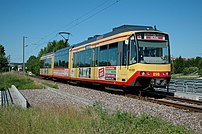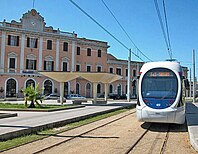Tram-train
A tram-train is a type of light rail vehicle that both meets the standards of a light rail system, and also national mainline standards. Tramcars are adapted to be capable of running on streets like an urban tramway but also be permitted operation alongside mainline trains. This allows services that can utilise both existing urban light rail systems and mainline railway networks and stations. It combines the urban accessibility of a tram or light rail with a mainline train's greater speed in the suburbs.[1]
The modern tram-train concept was pioneered by the German city of Karlsruhe in the late 1980s,[2] resulting in the creation of the Karlsruhe Stadtbahn. This concept is often referred to as the Karlsruhe model,[1] and it has since been adopted in other cities such as Mulhouse in France[1] and in Kassel, Nordhausen and Saarbrücken in Germany.[2]
An inversion of the concept is a train-tram – a mainline train adapted to run on-street in an urban tramway, also known as the Zwickau Model.
Technology
[edit]The tram-train often is a type of interurban[3] — that is, they link separate towns or cities, according to George W. Hilton and John F. Due's definition.[4]
Most tram-trains are standard gauge, which facilitates sharing track with main-line trains. Exceptions include Alicante Tram and Nordhausen, which are metre gauge.
Tram-train vehicles are dual-equipped to suit the needs of both tram and train operating modes, with support for multiple electrification voltages if required and safety equipment such as train stops and other railway signalling equipment. The Karlsruhe and Saarbrücken systems use "PZB" or "Indusi" automatic train protection, so that if the driver passes a signal at a stop the emergency brakes are applied.
History
[edit]The idea is not new; in the early 20th century, interurban streetcar lines often operated on dedicated rights-of-way between towns, while running on street trackage in town. The first interurban to emerge in the United States was the Newark and Granville Street Railway in Ohio, which opened in 1889. In 1924, in Hobart, Australia, sharing of tracks between trams and trains was proposed.[5]
The difference between modern tram-trains and the older interurban and radial railways is that tram-trains are built to meet mainline railway standards, rather than ignoring them. An exception is the United States' River Line in New Jersey, which runs along freight tracks with time separation; passenger trains run by day, and freight by night.
Existing systems
[edit]Asia
[edit]Japan
[edit]- Fukui: Fukui Fukubu Line
Europe
[edit]Austria
[edit]- Gmunden: Traunsee Tram (2018)[6]
- Vienna - Baden bei Wien: Badner Bahn
Denmark
[edit]France
[edit]- Lyon: Rhônexpress (2010)
- Lyon: Tram-train de l'ouest lyonnais
- Mulhouse: Mulhouse tramway[8]
- Nantes: Nantes tram-train (2011)
- Île-de-France (Paris region):
- Tramway Line 4 (2006)
- Tramway Line 11 Express (2017)
- Tramway Line 12 Express (2023)
- Tramway Line 13 Express (2022)
Germany
[edit]- Chemnitz: City-Bahn Chemnitz
- Karlsruhe: Stadtbahn Karlsruhe
- Kassel: Kassel RegioTram (2006)
- Nordhausen: Trams in Nordhausen
- Saarbrücken: Saarbahn
Hungary
[edit]Italy
[edit]Netherlands
[edit]Portugal
[edit]- Porto:
- Porto Metro Line B/Bx (opening 2005)
- Porto Metro Line C (opening 2005)
Spain
[edit]- Alicante: Alicante Tram (2007)
- Mallorca: Mallorca rail network
- Cádiz: Cádiz Bay tram-train (2022)
United Kingdom
[edit]- Sheffield - Rotherham: South Yorkshire Supertram (2018)
- Cardiff: South Wales Metro (2024)
North America
[edit]- New Jersey: River Line – diesel multiple units using main line tracks between Trenton, New Jersey and Camden, New Jersey in a time-sharing agreement with the freight companies.
- Puebla, Mexico: Puebla-Cholula Tourist Train (2017-2021; trains now sold to Tren Interoceánico)
- San Diego, California: San Diego Trolley
Proposed systems
[edit]Africa
[edit]Asia
[edit]Europe
[edit]- Braunschweig, Germany
- Bratislava, Slovakia
- Cardiff, United Kingdom. Wales & Borders franchise: South Wales Valley Lines (2022 - 2023) - rolling stock currently under construction.
- Debrecen, Hungary [10]
- Erlangen, Germany – an extension of Straßenbahn Nürnberg not initially planned to use mainline rail tracks but proposed to do so in the future. The planned line to Herzogenaurach replicates a former mainline rail line
- Gorzów Wielkopolski, Poland
- Greater Manchester, United Kingdom. Proposed extensions to the Manchester Metrolink network.[1][11]
- Grenoble, France
- Groningen, Netherlands
- Kiel, Germany
- Kyiv, Ukraine
- Košice, Slovakia[12] (in planning phase)
- León, Spain
- Liberec — Jablonec nad Nisou, Czech Republic
- Linköping, Sweden
- Linz, Austria (in planning phase)
- Manresa, Spain
- Metro Mondego, Coimbra, Portugal
- RijnGouweLijn, Netherlands
- Metro de Sevilla. Seville has one metro line and one tram line that are not connected, but the long-term intention is to link the metro and tram systems.
- Oradea, Romania - The first romanian tram-train will be in Oradea, featuring several lines, and connecting the city to the villages near, like Borș, Băile Felix or Sântandrei. The tram-train in Oradea is in planning phase, some parts of the project already accepted by the local government.
- Sevastopol[13]
- Strasbourg, France
- Szeged, Hungary. Two other destinations are being considered as of January 2022 besides the Szeged - Hódmezővásárhely line, which entered operation in November 2021. The Szeged - Subotica (Serbia) line is in early planning phase.[14] A preparatory study was also completed for the Szeged - Makó line,[15] but the estimated costs were high, and it is also dependent on a new road-rail bridge over the river Tisa only in planning phase as of now.
- TramCamp, Camp de Tarragona, Catalonia, Spain
- Wrocław, Poland (2005) — 600 V DC/3 kV DC
- Riga, Latvia
- Turku, Finland
- West Midlands conurbation, United Kingdom. Proposed extensions to the West Midlands Metro.
Oceania
[edit]- Adelaide, South Australia – On June 5, 2008, the Government of South Australia announced plans for train-tram operation on the Adelaide Metro's Outer Harbor/Grange train lines and City West-Glenelg tramline extension as part of a 10-year A$2 billion public transport upgrade.[16]
- Hobart Tasmania
South America
[edit]Vehicles
[edit]Models of tram designed for tram-train operation include:
- Alstom's RegioCitadis and Citadis Dualis, derived from the Citadis
- Bombardier Flexity Link and Bombardier Flexity Swift
- Siemens S70
- Stadler Citylink
Train-tram
[edit]
Europe
[edit]- Zwickau: Trams in Zwickau – on-board diesel generator (light-weight RegioSprinter diesel railbuses that also operate on street tramway)
North America
[edit]- Austin, Texas: Capital MetroRail – commuter rail that shares more commonality with train-tram operation, with downtown street running and usage of mainline track. Uses diesel multiple units.
See also
[edit]References
[edit]- ^ a b c d "Tram-train: Making new connections". tautonline.com. Tramways & Urban Transit. Retrieved 28 January 2022.
- ^ a b "Uk tram-train: Learning lessons". tautonline.com. Tramways & Urban Transit. Retrieved 28 January 2022.
- ^ "UrbanRail.Net > Europe > Germany > Hessen > Kassel Tram / Straßenbahn".
- ^ Hilton, George Woodman; Due, John Fitzgerald (2000) [1960]. The Electric Interurban Railways in America. Stanford University Press. Original preface, 1960 page ix.
- ^ "TRAMS AND TRAINS". The Mercury. Hobart, Tasmania. 12 February 1924. p. 6. Retrieved 21 April 2012 – via National Library of Australia.
- ^ "TRAUNSEETRAM - Stern & Hafferl Verkehr".
- ^ "Aarhus tram-train project gets the go-ahead". Railway Gazette International. 10 May 2012.
- ^ Haydock, David (April 2011). "France's first real tram train". Today's Railways. Platform 5 Publishing Ltd. pp. 37–40.
- ^ "Tram-Train for Haifa-Nazareth.(Transit News)". Archived from the original on 2014-06-29.
- ^ "Tram-trains may also run between Debrecen and Oradea in the future". www.debrecen.hu. Retrieved 2024-03-03.
- ^ Place North West (7 January 2019). "Metrolink heads to Stalybridge and Middleton in 2040 expansion". Archived from the original on 1 March 2021. Retrieved 30 September 2021.
- ^ "Planovane-modernizacie-elektrickovych-trati-MET-a-Integrovany-dopravny-system-IDS" (PDF).
- ^ "Agency Strategic Initiative" (PDF).
- ^ "Jöhet a Szeged-Szabadka tram-train, megjelent a tender – Szegedi hírek". Szeged365 (in Hungarian). 2021-12-02. Retrieved 2022-01-04.
- ^ "Szeged-Makó elővárosi közösségi közlekedés vizsgálata - Döntéselőkészítő Tanulmány (Közlekedés - Pro-Urbe - V-Plan - Uvaterv - Unitef)". Archived from the original on 2016-03-05. Retrieved 2012-12-22.
- ^ Adelaidemetro.com.au Archived July 21, 2008, at the Wayback Machine
- ^ "El tren tranvía ya tiene la firma para arrancar - Cali - Colombia - ELTIEMPO.COM".
External links
[edit]- TramTrain - the 2nd generation: Searching for the 'ideal' TramTrain-city
- New TramTrain for Mulhouse - Reportage and images (English/German)
- Construction of the TramTrain system in Mulhouse with images (English/German)
- tram-train of Karlsruhe transformed in a subway in the center
- Leeds City Region proposal
- (Jane's) Urban Transit Systems









